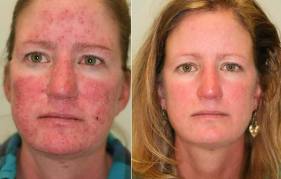Surprising Symptoms Of Rosacea and How to Treat It
Book Now
Rosacea is a skin condition that is quite common. Many people, when rosacea is mentioned, think of red splotchy cheeks, but there is so much more to this skin condition. The symptoms of rosacea flare up and calm down over time, usually the period of weeks or months. Many times it remains undiagnosed, or improperly diagnosed with conditions such as acne or allergies. It mainly affects middle-aged, white women but anyone can suffer from rosacea. So, to start, what can aggravate rosacea?
For one, rosacea is not caused by a lack of good hygiene. In fact, its causes are mostly unknown but believe to be a combination of environmental factors and family history. Things that can make rosacea worse, or trigger an episode, include:
- Alcohol consumption
- Drinking hot beverages
- Eating spicy food
- Sun and wind exposure
- Cosmetic use
- Exercise
- Emotional difficulties
- Drugs that dilate blood vessels
So what are the symptoms of rosacea?
There are four main symptoms of rosacea. Facial redness, swollen red bumps, eye problems, and an enlarged nose. The most common of these symptoms is facial redness.
Facial redness is not caused by inflammation, but rather the small blood vessels in your face swelling and becoming visible. Usually, this redness centers around a sufferers nose and cheeks. It is easier to spot and diagnose on those with lighter skin.
Swollen red bumps are often what is mistaken for acne, which results in the wrong treatment and no reduction in symptoms. These red bumps are small pimples and can, at times, contain puss. People who have this symptom often have tender and hot skin.
Eye problems affect around half of the people who suffer from rosacea. These symptoms include eye irritation, swelling, eye dryness, and reddened eyelids – similar to reddened cheeks and nose. Eye problems precede other skin symptoms in those that have them.
Having an enlarged nose is rare in people who have rosacea. The condition is called rhinophyma, and it is caused by the thickening of the skin on the nose. This thickening causes the nose to appear bulbous. It is more common in men who suffer from rosacea than it is in women.
If you believe that you have rosacea, your doctor or dermatologist can diagnose you through a history of symptoms and a physical examination. There is no set test, merely observation, and history. There are often tests done to rule out other conditions, however, such as acne before a diagnosis of rosacea is given.
Treatment for rosacea focuses on controlling the signs and symptoms of the condition. It can include medications, oral antibiotics, isotretinoin, which is a powerful acne medication.
There are skin therapies that can help with rosacea as well. Facials are a great way to help calm skin down and treat the tiny pimples that are caused by rosacea. You can also treat rhinophyma through various types of dermabrasion, as it is caused by a build-up of tissue.
At Derma Bright we have a multitude of treatments that will help people who have rosacea manage their symptoms. Facials are what we do best, and our calming treatments will help clear redness and pimples on your skin.

